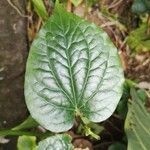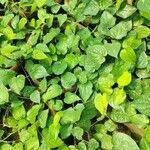| Therapeutic use
|
Cough (fruit), Androgen antagonists (leaf), Anemia (leaf), Anthelmintics (leaf), Anti-bacterial agents (leaf), Antifungal agents (leaf), Anti-infective agents, local (leaf), Anti-inflammatory agents (leaf), Antineoplastic agents (leaf), Antispermatogenic agents (leaf), Apnea (leaf), Asthma (leaf), Astringents (leaf), Brain diseases (leaf), Brain edema (leaf), Bronchitis (leaf), Cardiotonic agents (leaf), Cathartics (leaf), Chest pain (leaf), Common cold (leaf), Cough (leaf), Digestive system diseases (leaf), Dyspnea (leaf), Expectorants (leaf), Filariasis (leaf), Flatulence (leaf), Heart diseases (leaf), Hematologic diseases (leaf), Hoarseness (leaf), Lung diseases (leaf), Night blindness (leaf), Nootropic agents (leaf), Pain (leaf), Parasympatholytics (leaf), Periodontal diseases (leaf), General tonic for rejuvenation (leaf), Respiratory tract infections (leaf), Sinusitis (leaf), Snake bites (leaf), Thirst (leaf), Tooth diseases (leaf), Toothache (leaf), Reduced salivation (leaf), Contraceptive agents (root), Infertility, female (root), Sterilization, reproductive (root), Abscess (unspecified), Antiseptic (unspecified), Asthma (unspecified), Carminative (unspecified), Cough (unspecified), Earache (unspecified), Epistaxis (unspecified), Gingivitis (unspecified), Gonorrhea (unspecified), Hoarseness (unspecified), Lactafuge (unspecified), Leucorrhea (unspecified), Masticatory (unspecified), Mucositis (unspecified), Otosis (unspecified), Parturition (unspecified), Pimple (unspecified), Sore (unspecified), Expectorant (unspecified), Halitosis (unspecified), Toothache (unspecified), Itch (unspecified), Stimulant (unspecified), Stomachic (unspecified), Adenopathy (unspecified), Antioxidant (unspecified), Aphrodisiac (unspecified), Astringent (unspecified), Bactericide (unspecified), Bite(Snake) (unspecified), Bruise (unspecified), Cancer (unspecified), Catarrh (unspecified), CNS depressant (unspecified), Colic (unspecified), Tuberculosis (unspecified), Contraceptive (unspecified), Diphtheria (unspecified), Edema (unspecified), Eye (unspecified), Fungicide (unspecified), Inflammation (unspecified), Laryngitis (unspecified), Liver (unspecified), Lung (unspecified), Malaria (unspecified), Phthisis (unspecified), Preventitive(Malaria) (unspecified), Rheumatism (unspecified), Satyriasis (unspecified), Sterilizant (unspecified), Swelling (unspecified), Syphilis (unspecified), Thirst (unspecified), Tumor (unspecified), Wound (unspecified), Bronchitis (unspecified), Anodyne (unspecified), Inhalant (unspecified), Womb (unspecified), Dysentery (unspecified), Pregnancy (unspecified), Preventitive (unspecified), Sore(Throat) (unspecified), Congestion (unspecified), Digestive (unspecified), Gargle (unspecified), Anthelmintics (unspecified), Anti-infective agents, local (unspecified), Antipyretics (unspecified), Antirheumatic agents (unspecified), Aphrodisiacs (unspecified), Appetite stimulants (unspecified), Astringents (unspecified), Common cold (unspecified), Conjunctivitis (unspecified), Diarrhea (unspecified), Digestive system diseases (unspecified), Dyspepsia (unspecified), Erectile dysfunction (unspecified), Expectorants (unspecified), Fever (unspecified), Filariasis (unspecified), Flatulence (unspecified), Laryngeal diseases (unspecified), Laxatives (unspecified), Leprosy (unspecified), Lung diseases (unspecified), Night blindness (unspecified), Pharyngitis (unspecified), General tonic for rejuvenation (unspecified), Skin diseases (unspecified), Syncope (unspecified), Reduced salivation (unspecified)
|




